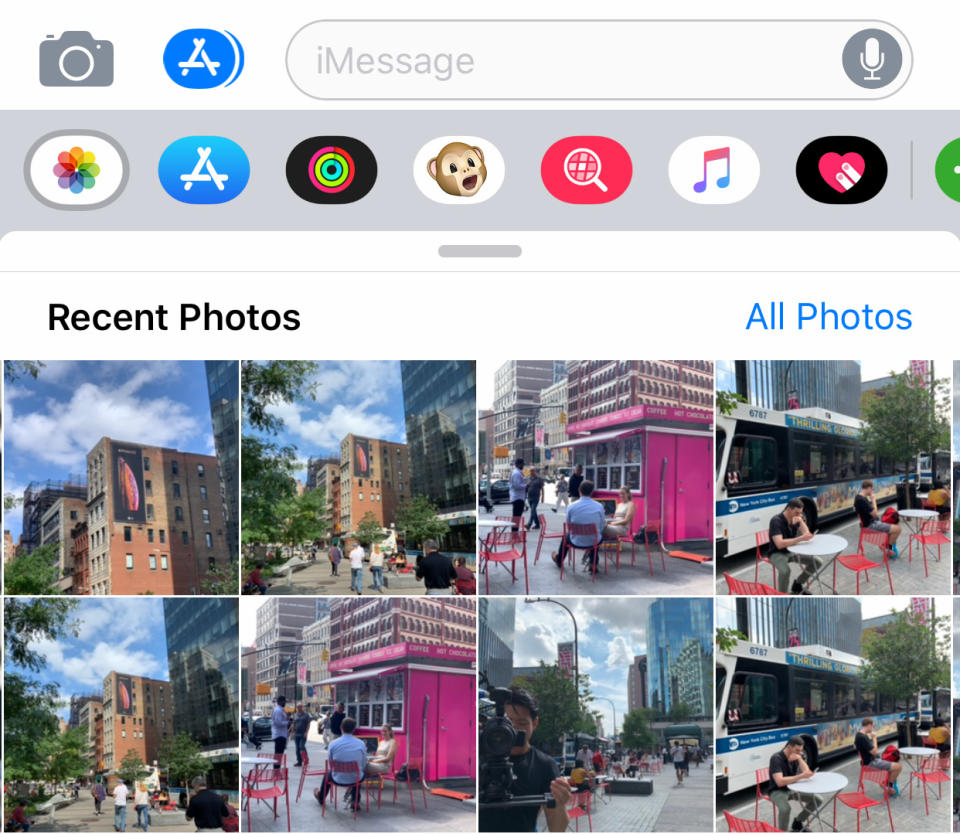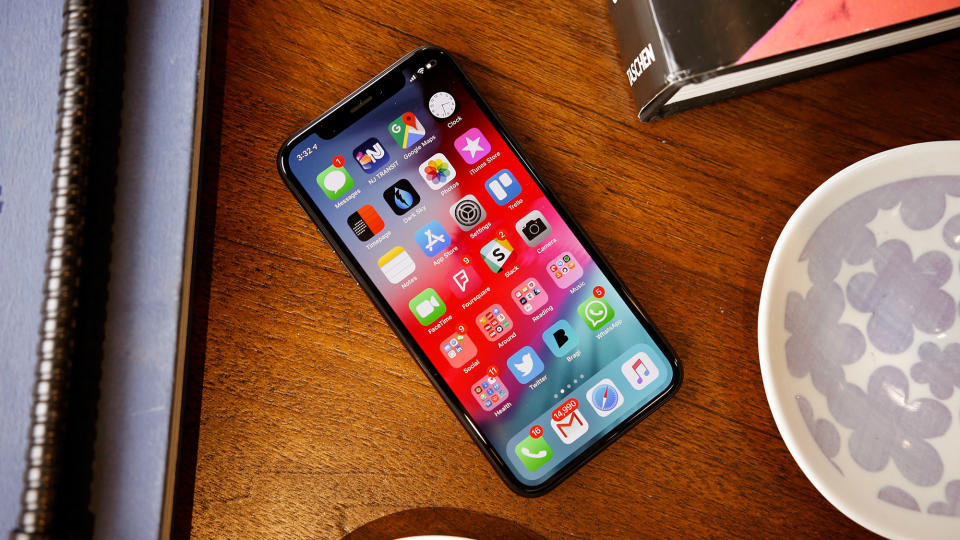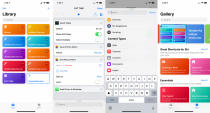Apple iOS 12 review: Less mess
There's plenty here for newcomers and longtime Apple fans alike.
The wait is over: After a splashy announcement at Apple's Worldwide Developer Conference in June, iOS 12 is finally ready. And the best part? While it's far from the flashiest iPhone update ever -- there's no visual overhaul here or many hyped-up new features -- iOS 12 might be the most pleasant Apple software update I've ever used.
Yes, "pleasant" -- not "feature-packed." As reported many, many times even before the announcement, Apple's developers focused on sanding down the software's rougher edges and making iOS as a whole faster and easier to use. That was no small feat, especially when you consider the number of issues that wound up plaguing last year's big software release. For once, Apple crafted a software update that feels just as valuable on old hardware as it does on the shiny new stuff.

Lots of fine-tuning
In late 2017, Apple confirmed something many of us had suspected for years: iOS was designed to limit your phone's performance when its battery life degraded over time. Mechanically, the idea is sound: To combat the random shutdowns that sometimes occurred when an iPhone's battery wasn't up to snuff anymore, iOS dialed down the performance all around. Of course, that disclosure didn't go over very well. Regardless of intent, it sure felt like Apple was trying to give older iPhone owners a reason to go out and buy another phone.
Things are a little different with iOS 12. Apple's biggest claim for this year's software update is that it improves iOS' overall speed, even on devices that the company hasn't sold in years. As with the iOS 12 preview I wrote a few months ago, I spent most of my testing of this new update on an iPhone X, and you probably don't need me to tell you it runs great on Apple's highest-end smartphone. (Well, highest-end for now, anyway.)
Since then, though, I've installed multiple versions of iOS 12 on the oldest iPhone we still had kicking around the office -- a lovely pink iPhone SE -- and the difference is noticeable. Apps launched a little faster. Switching between those apps seemed just a touch smoother. The phone didn't take quite as long to boot up. These might not sound like huge differences, and if we broke out the stopwatch, we'd be measuring changes in fractions of a second. Even so, all the low-level nipping and tucking Apple did made this two-and-a-half-year-old phone feel nearly as fresh as the day I unboxed it.
That's a pretty big deal, especially when you consider what you can actually install iOS 12 on. The new update is compatible with every iPhone since the 5S and every iPad since the mini 2. For those not keeping track, those devices are five years old now -- if you're still using any of them, you know they don't run the way they used to. And for once, an OS update is actually going to help rather than make things worse.

Beyond those valuable, system-level changes, Apple also tricked out iOS 12 with smaller features that make getting certain things done way easier. Hate having to check your Messages inbox when you need to punch a security code into an app? Me too, but iOS helpfully plugs them in for you. Face ID -- which is Apple's preferred unlock method for the foreseeable future -- now lets you set up an additional face, which has been really helpful when our video guy Brian needs to poke around on my phone. And since QR codes are somehow still a thing, it's nice that iOS makes it a little faster to scan them.
iOS 12 packs a handful of tweaks that fix some of my biggest pet peeves. If you're an iPhone X user, you've almost certainly taken an accidental screenshot of your home screen while pulling the phone out of your pocket or bag. Well, not anymore: Hitting the power and volume keys while the screen is locked no longer triggers a screenshot. And I've never liked that the iPhone X made you press and hold on an app card before you could swipe up and kill it. Thankfully, a quick swipe up is now all you need to force an app closed from the multitasking view. Palm nailed this gesture nearly a decade ago, so I'm glad Apple has finally seen the light.
None of these smaller changes by themselves would be much to write home about, but taken together, they make iOS 12 feel more capable and whole. Considering Apple's rough patch with iOS 11, the added layer of polish this year is enough to make iOS 12 a must-install. Of course, there's a whole lot more to iOS 12 than that.
Tools for a better you
When Steve Jobs revealed the original iPhone in June 2007, he introduced it as an iPod, a phone and an internet communicator. His definition wasn't wrong, but the following 11 years have made it clear that those labels are lacking. I know people who spend nearly every waking moment on their phones, and you probably do too. It's helpful, then, that Apple has introduced new tweaks and tools in iOS 12 to help curb those obsessive tendencies.
Maybe the most apparent change lies in how iOS 12 now manages your notifications. Up until recently, it didn't take long for lock screens to become totally inundated with them: For me the idea of sifting through all of them was mildly panic-inducing. This year though, Apple finally listened to its users and started bundling together incoming notifications. And even better, you can dismiss them all with one swipe.

At first glance it might look like iOS is lumping notifications together by app, but that's not exactly the case. By default, notifications are clustered in such a way that certain threads or conversations might appear independently from all the other alerts that app has generated. Let's say you've been shooting emails back and forth with a certain someone all day. Most notifications from the Mail app will wind up in a single pile, but the updates to the thread you've been interacting with might appear as distinct alerts. iOS 12 doesn't always get this right, so you'll still need to be at least a little fastidious about checking your notification bundles. But this is a step forward that's long overdue.
This is assuming you want to keep dealing with your notifications in the first place. If you're totally over them, you can set apps to push notifications straight into your Notification Center rather than make a sound or slide down from the top of the screen. And if you're into the nuclear option, you could always prevent apps from generating alerts altogether. I don't know that I could ever pull the trigger on that last bit, but a guy can dream, can't he?
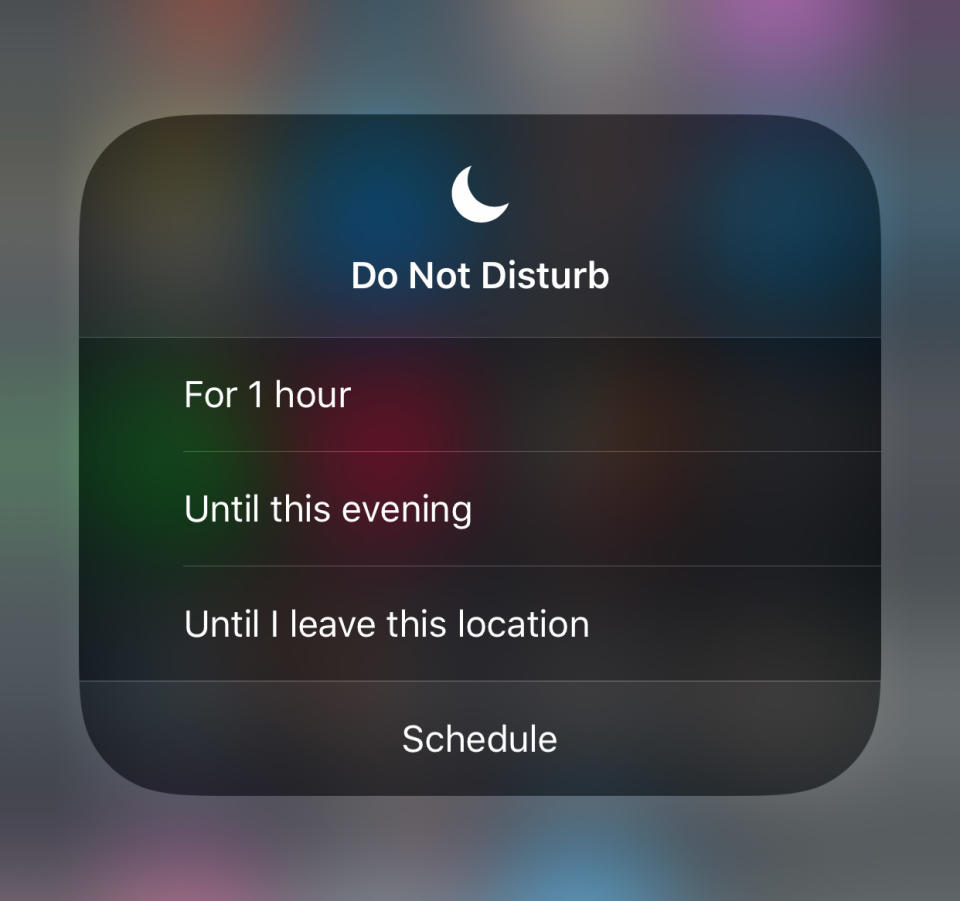
Thankfully, Do Not Disturb offers more ways to put off dealing with notifications. You can now set the feature to keep your phone quiet for a certain period of time or as long as you remain in the same location. The improved DND can also be set to expire once a pre-made calendar event ends, which in my case made for a few very quiet, very pleasant dinners. And Do Not Disturb at Bedtime -- yes, that's actually what the feature is called -- comes in remarkably handy when it's time to wind down for the day. It hides all notifications until the following morning, when it greets you with a neat Good Morning screen (complete with weather info).

Of course, the big addition on this front is Screen Time. Like Google did with Digital Wellbeing, Apple's new tool shines a light on what you do with your phone and when you do it. You'll find the feature in your device's settings, and so far, my results haven't been very encouraging: I apparently sift through tweets and like photos on Instagram to the point where social networking is far and away my most used app category.
That's not necessarily great, but I can't say it's a surprise: When it's time to get work done, I prefer to be at a proper computer. What's really not good is the number of notifications I typically deal with: In the past week, my phone has thrown up nearly 1,000 of them, averaging out to about 140 notifications per day. Fold in the fact that I tend to pick up my phone about 86 times per day and the nature of my relationship with my phone comes into sharper focus. I get distracted by my phone, a lot.
So I've started to do something about it. I now have limits placed on how long I get to use Instagram and Twitter on my iPhone -- 30 minutes per day each -- and seeing Screen Time's weekly recaps reminds me to be a little more hands-off on a daily basis. Ultimately, all Apple is doing here is giving you raw data and some tools to help you act on it. Whether you actually decide to do something with all of that remains your choice, but I'm at least thankful for this extra insight.
More ways to communicate
We rely on our smartphones to keep us connected to other people, so it's no surprise that Apple wanted its Messages to act more like some of its biggest competitors'.
You won't notice much as you jump into your message threads, but look a little closer and you'll find... well, you'll find a lot of light-hearted weirdness. Consider the camera. Once launched, you can attach new shapes and add stickers to your subject before you even snap a photo, which gives the whole thing a distinctly Snapchat vibe. While I've had a little more fun sticking virtual objects to my selfies than I'd care to admit, the change means that selecting and sending photos you've already taken requires an extra step.

It used to be that tapping the Camera icon in Messages would give you a tiny viewfinder and a handful of recent photos you could immediately fire off. This year, though, you'll have to select those photos from a completely distinct iMessage app. I eventually got used to it, but this is one case where I wish Apple had just left things the way they were.

There are more Animoji this year, but Memoji are the big new addition in iOS 12. In case you're not up to speed, you can do more than just put on a virtual T-Rex mask for your silly messages: You can cobble together your own, with dozens of options for skin tones, hairstyles, eyebrows, head shapes and more. If you've ever agonized over creating the perfect Mii, you have a good idea of what to expect. The thing is, the novelty of putting a virtual face on top of my real one didn't last long when Animoji debuted last year, and Memoji hasn't changed that. Don't get me wrong: I spent the better of 10 minutes meticulously building a chubby, brown, Pixar-like Memoji and had a great time doing it. I just can't remember the last time I -- or anyone I knew using iOS 12 -- actually used one in a conversation.
This would've been the part of the review where I talked about the pure madness that is a 32-person Group FaceTime call but, uh, the feature isn't actually ready yet. Curiously enough, Apple yanked support for those massive chats from this release even though it was present -- and mostly functional -- in the earlier beta builds. Apple has never offered a reason for its decision, so all we can do is wait until the feature goes live sometime this fall.
Siri, suggestions and shortcuts
You probably know Siri best as a chatty virtual assistant (and one with a bad rap, no less). In iOS 12, though, you'll see Siri pop up in ways you might not have seen coming. If you miss a call from a friend, a notification will pop up to make sure you call her back. If you have a calendar event set for early in the morning, Siri will mention that setting an early alarm might be a good idea. Rather than wait for you to ask for help, this year's version of Siri actively tries to help you get things done.

These suggestions are part of Siri's new shortcuts, and the assist looks at a long list of data points to figure out what it should suggest to you and when. Your location, the current time, how you're moving -- Siri keeps tabs on all these and more to help inform its suggestions. While that might sound a little creepy, all that behavioral data stays on your iOS device and genuinely helps Siri feel more proactive. In my experience, these new suggestions don't pop up too frequently, but that'll almost certainly change as developers continue to give Apple's assistant access to the data and actions contained in their apps.
I sort of prefer the serendipitous way Siri shows me shortcuts when it thinks I need them, but you can also create your own voice-activated shortcuts in your device's settings. It's about as straightforward as the process could be: You pick an app action you'd like Siri to fire up and record a voice command. So far, these homemade shortcuts have come in handy when I'm sitting down to interview someone ("Hey Siri, start recording" creates a voice memo) or catching up on news at the end of the day ("Hey Siri, news me" takes me to Apple News's spotlighted stories). And if you want to take this whole thing a little further, there's the new Shortcuts app.

Long story short, the Shortcuts app lets you string together multiple shortcut actions into a sort of macro you can either launch from your home screen or activate by talking to Siri. If you're a longtime Mac user, think of it as Automator for your iPhone. After using the app for a while, it's clear why Apple didn't bundle it with this update: Shortcuts is one of the few additions to iOS I've seen that feels like a nod to power users.
If you (for some reason) wanted to search Giphy for some animated cats, save one of those images to your phone and immediately send it to a cat-obsessed friend via WhatsApp with a few taps, that's totally doable. (That's about as complex as I could get before I had to turn to the built-in shortcut gallery for inspiration.) Even now, highly complex shortcut recipes are making the rounds, and they speak to the truly impressive depth available here. In an update that's mostly centered on adding polish, Shortcuts is easily the most impactful new feature. If you have the head for it, it could completely change how you use your iOS device. Just looking at the shortcut-creation screen can feel a little daunting, but trust me: The gallery of pre-made shortcuts is vast, and it's worth at least trying.

Everything else
We've hit most of iOS 12's high points, but as always, there are a lot of other substantial changes that don't fit into what seem like the update's major themes. Let's take a look.
Apple's Voice Memos app got a major facelift, and it finally works on the iPad too. More importantly, you can now use Voice Memos to edit the recordings you've just made. This has been really helpful for editing recorded interviews for clarity before I pass the files off to be transcribed. (Side note: Apple, if you could build an AI transcriber into iOS, you'd be a hero among journalists.)
Apple Books has a new look too. All told, the redesign makes it easier to find new books, see where you left off in that page-turner and hunt for audiobooks. The update will mean a lot to people who have already invested loads into Apple-friendly e-books, but I'm a Kindle devotee so this is less important for me.
As part of Apple's focus on augmented reality, iOS 12 includes an AR tape measure. The idea itself isn't new -- Google built one years ago when it was pushing its Project Tango devices -- but always having a tape measure around came in really handy when I was looking for a new apartment.
iOS 12 now has some handy graphs, so it's easier to gauge how well your battery is going in a given day. File this one under "Things iOS needed that Android has done for years."
CarPlay finally (finally!) plays nice with third-party navigation apps, which came in surprisingly handy when driving rental cars at Apple's most recent iPhone event.
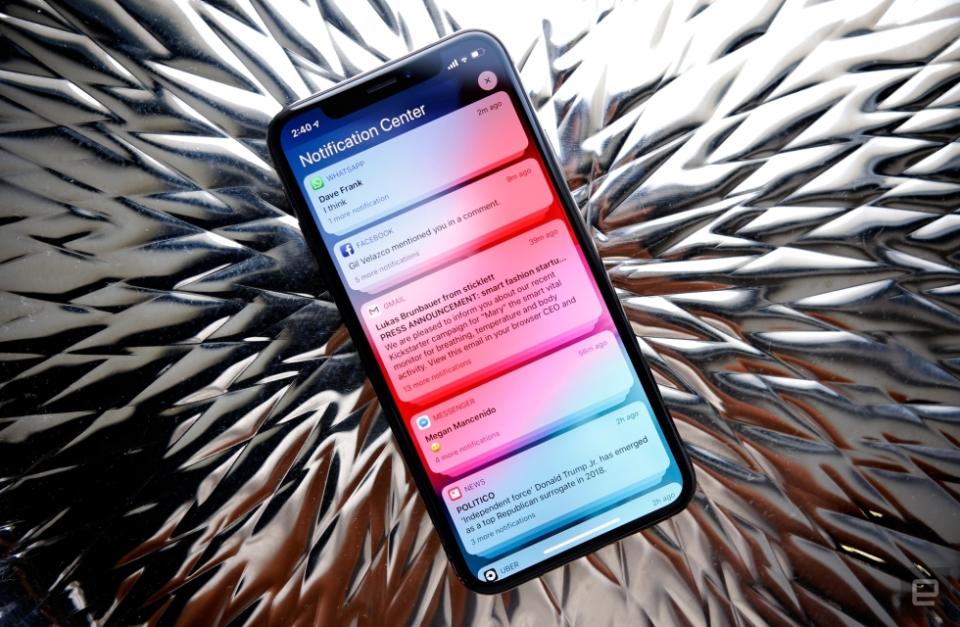
Wrap-up
iOS 12 might be light on momentous features, but that doesn't really matter. By focusing on polish over breakneck progress, Apple has put together what feels like the most complete, thoughtful version of iOS I've seen in a long time. And even better, people who still use some of Apple's most modest hardware stand to benefit from this release too. (Try saying that about iOS 11.) This is a free update, and I have to imagine the iOS devotees among you have probably already taken the plunge. To everyone else, go ahead and install it. It's for the best.












